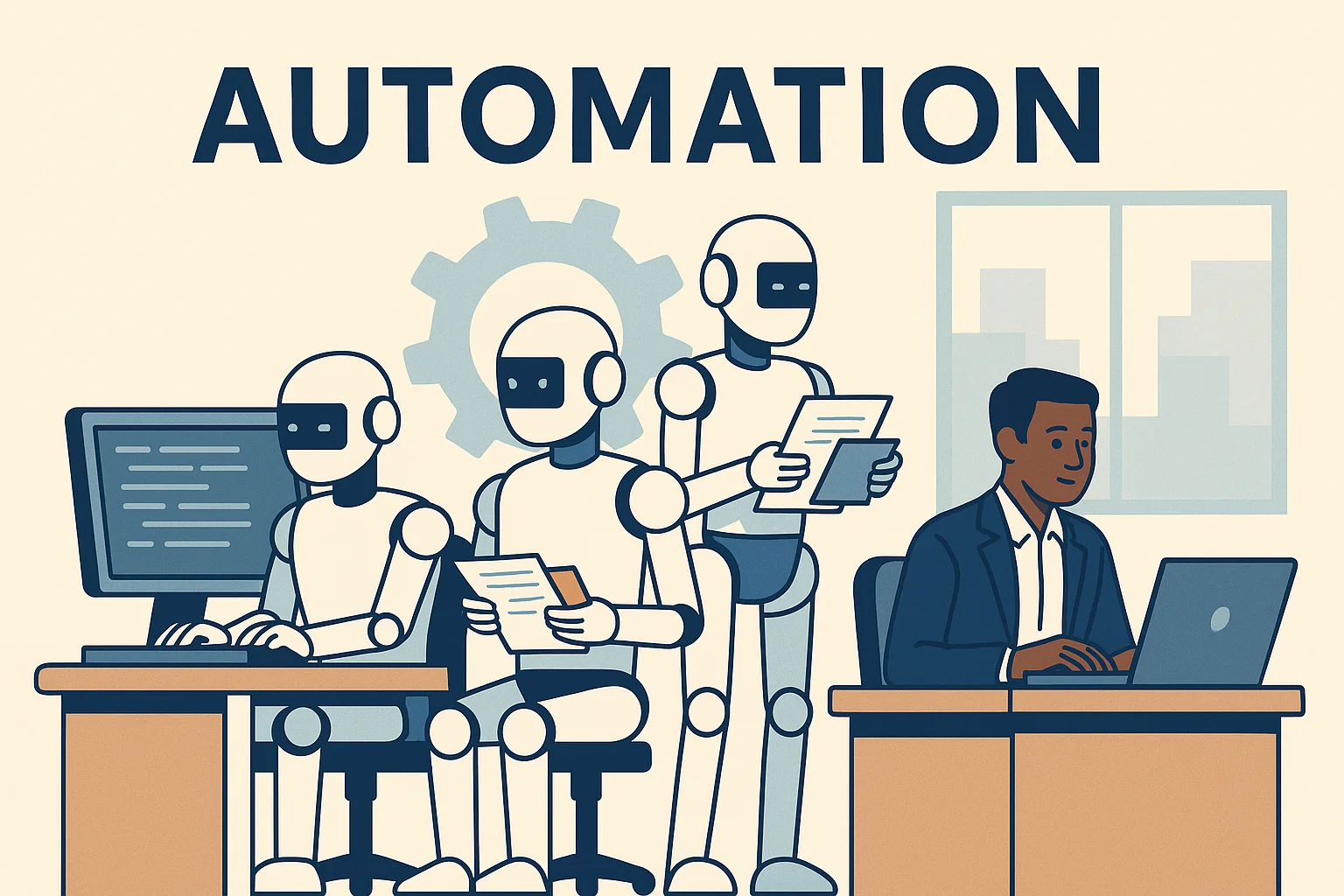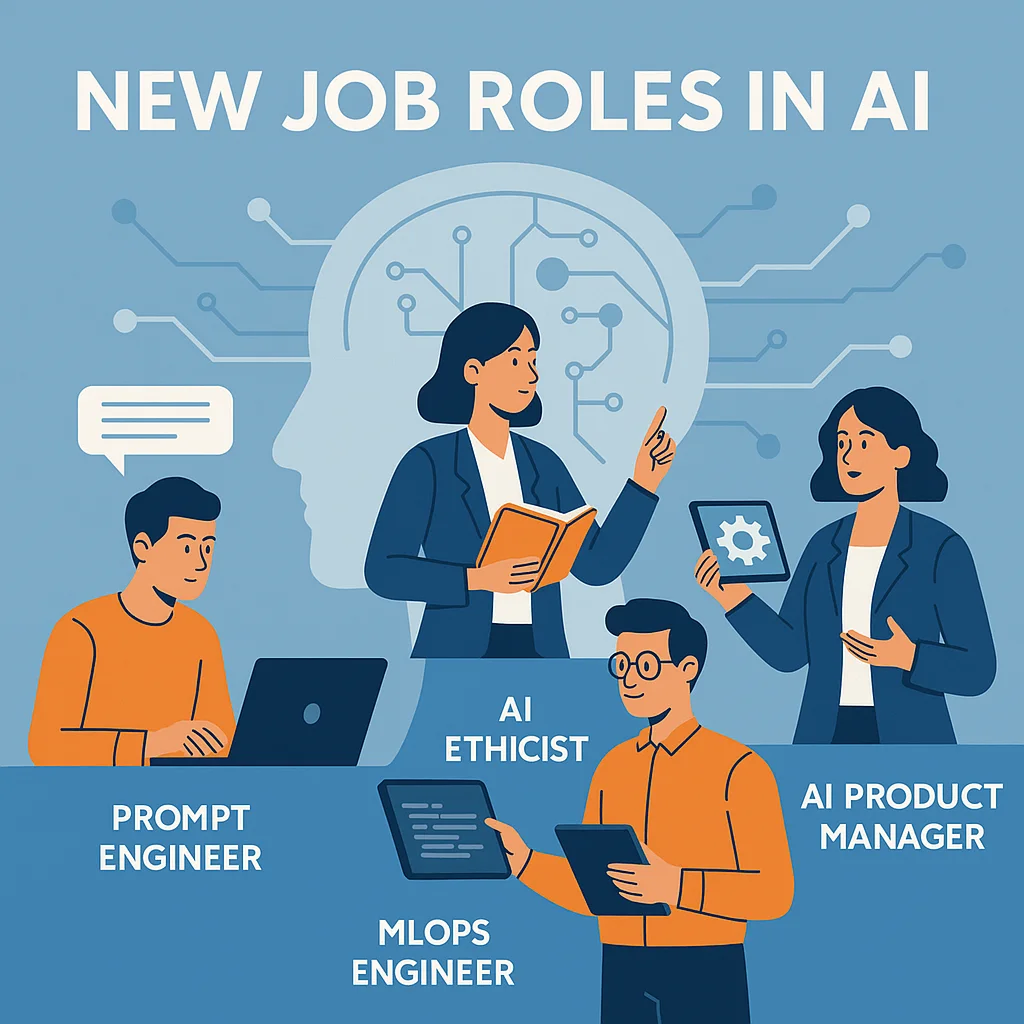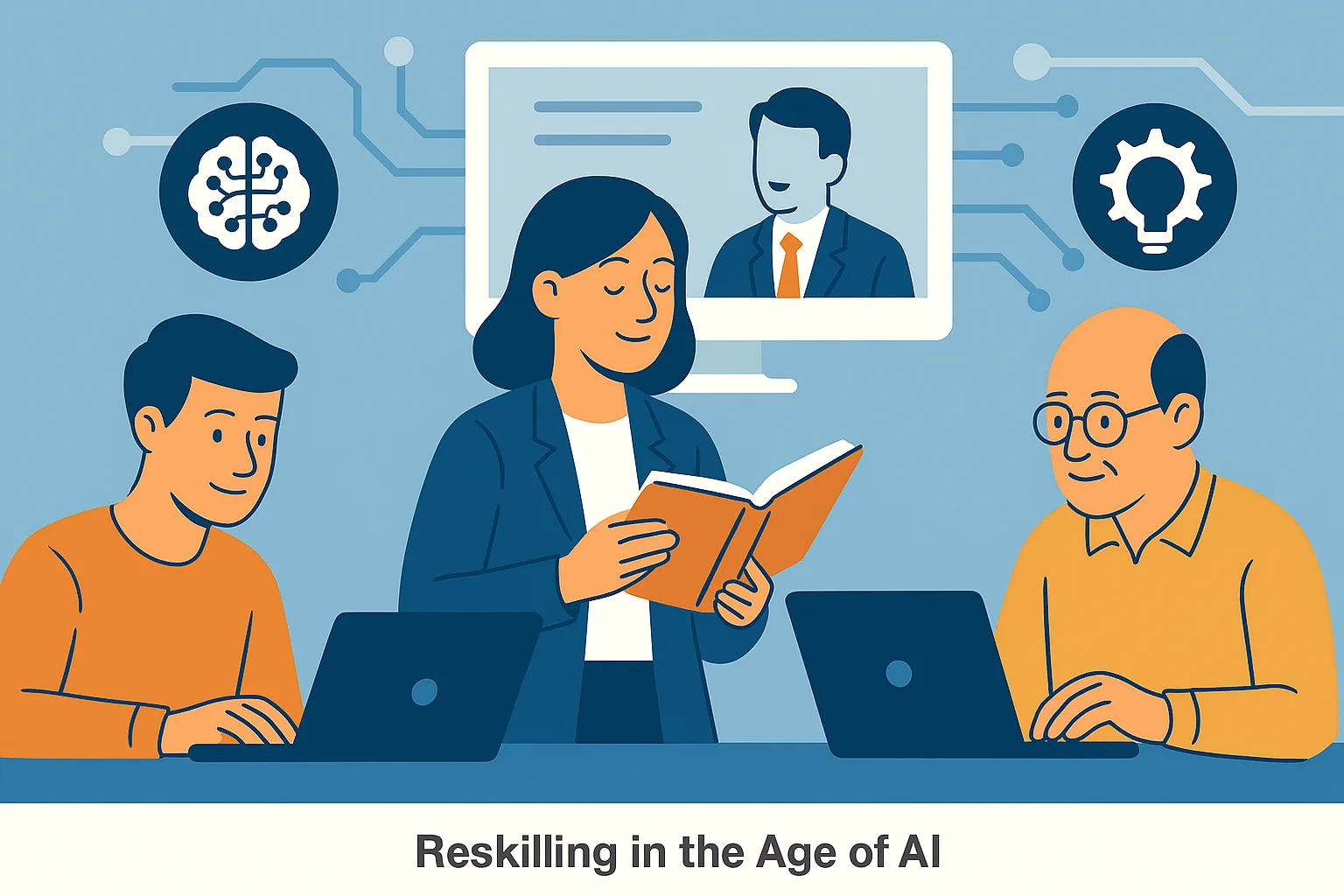How AI Is Changing the Job Market: Automation, Augmentation, and New Opportunities

Introduction
Artificial Intelligence is no longer just a buzzword — it’s a catalyst reshaping the global job market. From automating repetitive tasks to enhancing high-skill professions and creating entirely new roles, AI is forcing companies, workers, and governments to rethink how labor is valued, structured, and rewarded.
This shift isn’t just about robots replacing humans. It’s about how AI is blending into everyday workflows, amplifying productivity, and changing the skillsets needed to thrive. The impact isn’t uniform across sectors or regions, and the consequences — both positive and disruptive — are still unfolding.
In this article, we explore how AI is affecting different types of work, who’s most at risk, who’s benefiting, and what the job landscape might look like in the near future.
Automation of Routine Tasks
The most immediate and visible impact of AI on the job market is the automation of routine, repetitive work. Tasks that follow clear rules and involve structured data are particularly susceptible.
Examples of high-risk roles:
- Data entry clerks
- Transcriptionists
- Retail cashiers
- Basic customer service agents
- Back-office administrative roles
For instance, banks are using AI chatbots to handle routine customer inquiries. Hospitals use voice-to-text transcription to automate medical note-taking. Law firms employ AI to comb through legal documents during discovery. In all these cases, what once required human input is now managed — faster and cheaper — by machines.
A 2023 report by Goldman Sachs estimated that up to 300 million jobs worldwide could be exposed to some level of automation by generative AI, particularly in white-collar fields like office support and legal administration. But this doesn’t necessarily mean those jobs will vanish — they may simply evolve.
Job Augmentation and Productivity Boosts
While automation makes headlines, augmentation is the more widespread — and often more powerful — trend. Rather than replacing workers, AI is increasingly acting as a copilot: assisting with tasks, suggesting improvements, and handling the mundane so humans can focus on the strategic.
Examples of AI augmentation in practice:
- Software developers use tools like GitHub Copilot to autocomplete code and suggest fixes.
- Writers and marketers use language models to draft content, brainstorm ideas, or optimize headlines.
- Financial analysts use AI to identify trends, flag anomalies, and visualize reports.
- Doctors and radiologists use AI to highlight abnormal scans or suggest diagnoses for rare conditions.
According to McKinsey, AI can improve individual worker productivity by 20%–30% in tasks involving decision-making, planning, and content creation. In many cases, companies find that giving each employee access to AI tools yields greater returns than automating a position entirely.
This augmentation trend is especially valuable in professions where soft skills, creativity, or human judgment still matter. Think of teachers designing custom lesson plans with AI support, or HR professionals using AI to screen resumes — but still making the final call.
New Job Roles Created by AI

AI doesn’t just eliminate roles — it creates new ones. Entirely new categories of work have emerged to support, guide, and regulate the use of artificial intelligence.
Emerging job titles include:
- Prompt Engineer — Crafts the queries that generate useful outputs from models like GPT or Midjourney.
- AI Ethicist — Ensures AI systems align with ethical, legal, and cultural norms.
- Machine Learning Operations (MLOps) Engineer — Manages deployment and maintenance of AI models.
- Synthetic Data Specialist — Designs artificial datasets for training models when real data is scarce or sensitive.
- AI Product Manager — Oversees the development of AI-enhanced products and manages the interface between model capabilities and user needs.
These roles require a mix of technical literacy, domain knowledge, and creative problem-solving. And they’re not just in Big Tech — AI roles are growing across healthcare, finance, media, education, and public services.
LinkedIn’s 2024 Emerging Jobs Report found that AI-related roles were among the fastest-growing globally, with demand for AI specialists increasing by over 74% in just two years.
Industries Most Affected (and Least)
AI is not hitting all sectors equally. The level of disruption often depends on how digital, automatable, or data-rich a given field is. Here’s a breakdown of how various industries are being affected:
Highly impacted industries:
- Finance: AI automates fraud detection, customer service, risk modeling, and algorithmic trading.
- Healthcare: Radiology, diagnostics, billing, and personalized treatment planning are increasingly AI-supported.
- Legal: Document review, contract analysis, and case research are being augmented by NLP tools.
- Retail and e-commerce: AI powers chatbots, inventory management, personalization, and pricing.
Moderately impacted industries:
- Education: AI tools help generate lesson plans, automate grading, and support student learning — but teachers are still essential.
- Manufacturing: Robotics and predictive maintenance are key AI applications, though physical processes often limit full automation.
- Marketing and media: Content generation is increasingly AI-assisted, but brand strategy and creative oversight remain human-led.
Less impacted (for now):
- Skilled trades: Electricians, plumbers, and mechanics rely on physical tasks in unpredictable environments — harder to automate.
- Social work and counseling: Empathy, trust, and human interaction remain at the core of these professions.
- Arts and performance: While AI can generate content, live performance, physical art, and originality still favor human creators.
In short, the more structured and digitized the task, the more likely it is to be affected by AI. But even in “safe” professions, auxiliary tasks (like scheduling or documentation) are likely to be automated — changing the nature of the work even if the role persists.
Reskilling and the Education Gap

As AI continues to reshape the job market, one of the most pressing challenges is the growing skills gap. Many existing workers — particularly in administrative, clerical, or low-tech roles — may not have the digital literacy or domain knowledge needed to adapt to AI-augmented environments.
This has triggered a global wave of reskilling initiatives. Companies, governments, and educational institutions are racing to equip people with the abilities needed to work alongside AI.
Examples of reskilling in action:
- Amazon’s Career Choice program funds training in IT, cloud computing, and healthcare.
- IBM’s SkillsBuild offers free AI-focused courses aimed at underserved communities.
- Community colleges and bootcamps now offer fast-track training in data analysis, prompt engineering, and ethical AI.
But progress is uneven. High-income countries and large companies tend to offer better access to training than small businesses or workers in developing economies. Even within organizations, reskilling often favors higher-educated employees.
According to the World Economic Forum’s 2023 report, 44% of workers’ core skills will change by 2027, but only 50% of workers currently have access to adequate training. This makes closing the education gap one of the most important — and urgent — challenges in ensuring AI benefits everyone.
Freelancing, Gig Work, and Global Competition
AI isn’t just changing what people do for work — it’s also changing how they work. The rise of remote-friendly, AI-powered productivity tools is accelerating the freelance and gig economy, enabling more people to work from anywhere — and for anyone.
Freelancers can now:
- Use AI to speed up deliverables (e.g., editing, writing, coding)
- Offer AI consulting or prompt engineering services on platforms like Upwork and Fiverr
- Work across time zones using asynchronous collaboration tools enhanced by AI summaries or translation
But this global flexibility introduces new competitive pressure. A copywriter in Canada might now compete with a designer in Brazil or a developer in India — all using the same generative tools. While AI can amplify individual output, it also compresses wage differentials across geographies, especially in knowledge work.
There’s also the issue of platform dependency. Many gig workers rely on marketplaces that are themselves experimenting with AI — potentially replacing or undercutting human sellers. For example, graphic design marketplaces may promote AI-generated art templates, while writing platforms experiment with LLM-based content generation.
This creates a paradox: AI makes it easier to work independently, but also harder to stand out unless you can uniquely combine AI with personal expertise, creativity, or client trust.
Equity and Access: Who Benefits Most?
AI has the potential to democratize opportunity — but without thoughtful implementation, it risks widening existing inequalities. The question of who benefits most from AI is not just economic — it’s also geographic, racial, and generational.
Uneven access appears across multiple dimensions:
- Geography: Urban, tech-driven regions see more job creation, while rural areas face job loss without AI investment.
- Education: Those with advanced degrees or digital skills are more likely to integrate AI into their work successfully.
- Income: High-income workers are more likely to experience productivity boosts, while low-income workers face higher automation risk.
- Language and culture: Most LLMs are trained primarily in English, limiting their usefulness in non-English-speaking markets.
There are also algorithmic equity concerns. AI used in hiring, lending, or education can unintentionally replicate bias if trained on flawed historical data. This puts historically marginalized groups at risk of being excluded or misjudged by opaque systems.
To ensure equitable outcomes, organizations and policymakers must:
- Invest in public access to AI education
- Build bias detection tools and ensure AI transparency
- Support universal reskilling programs
- Involve diverse voices in AI governance
Without such measures, AI may deepen divides — making it even harder for vulnerable populations to find stable, rewarding work in a changing world.
Long-Term Forecasts: Utopia or Disruption?
What does the future hold for work in an AI-driven world? It depends who you ask.
Optimistic forecasts suggest:
- Human-AI collaboration will unlock new productivity frontiers
- People will spend less time on drudgery and more on creativity and strategy
- Entire industries will emerge around AI ethics, safety, and services
- Shorter workweeks and better work-life balance may become feasible
Cautious or pessimistic forecasts warn:
- Mass displacement of middle-skill jobs could erode the middle class
- Income inequality may worsen if AI wealth accumulates among elites
- Job polarization could leave people stuck between high-skill and low-pay work
- Society may struggle to redefine the meaning of work, purpose, and status
Reports from organizations like McKinsey, PwC, and the World Economic Forum often blend both views. While many jobs will disappear, others will be created — often requiring new skills or more advanced digital fluency. The transition will likely be turbulent.
The net effect depends on how well society manages the shift — through education, social safety nets, regulation, and corporate responsibility. Without coordinated action, disruption may outweigh opportunity. With the right strategy, however, AI could usher in a new era of productivity, flexibility, and human-centered work.
Conclusion
AI isn’t simply taking jobs — it’s transforming them. It’s automating repetitive work, augmenting human capabilities, creating new career paths, and restructuring how and where people work. But it’s also introducing fresh challenges: skills mismatches, wage compression, and deeper inequality.
The true impact of AI on the job market won’t be defined by technology alone, but by how we respond to it — through education, policy, inclusion, and innovation.
The future of work is not man versus machine. It’s people learning to work with machines — and shaping systems that empower everyone, not just the digitally privileged. If we get that right, AI won’t just change jobs. It will improve them.